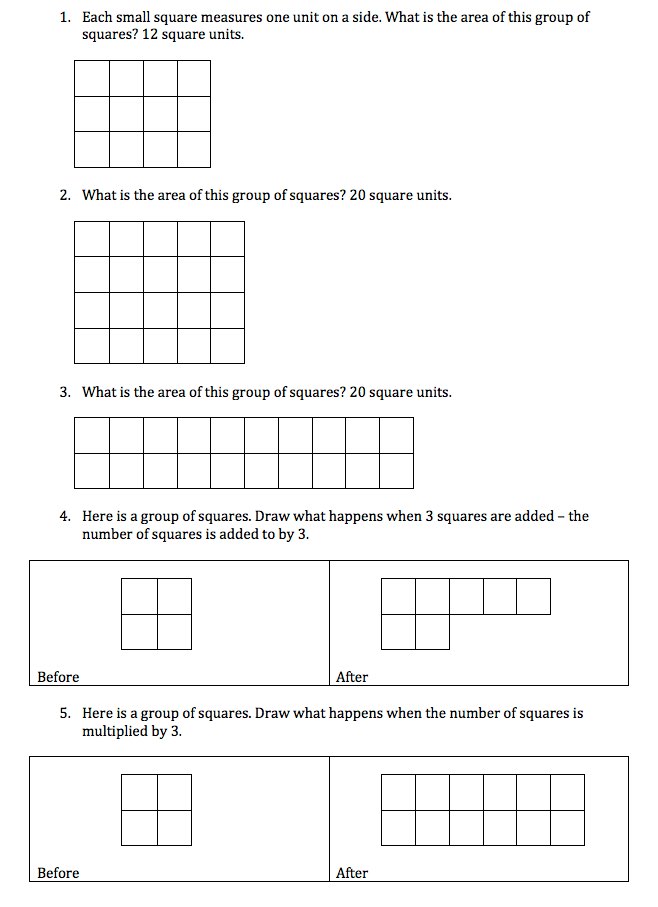Week 2: Multiplication – Day 5
What is the missing number?
1. 42 = 6 x 7 = ? x 14
6 x 7 = 3 x 2 x 7 = 3 x 14
So the missing number is 3.
2. 52 = 2 x 26 = 4 x ?
2 x 26 = 2 x 2 x 13 = 4 x 13
So the missing number is 13.
3. 84 = 7 x 12 = 21 x ?
7 x 12 = 7 x 3 x 4 = 21 x 4
So the missing number is 4.
4. 48 = 8 x 6 = 16 x ?
8 x 6 = 8 x 2 x 3 = 16 x 3
So the missing number is 3.
5. 72 = 8 x 9 = ? x 18
8 x 9 = 4 x 2 x 9 = 4 x 18
So the missing number is 4.
Week 2: Multiplication – Day 4
Multiplication Patterns
1. How can you tell if a number is a multiple of ten?
Its ones digit is zero. Examples of multiples of ten: 10, 100, 3240, 9600
2. How can you tell if a number is a multiple of five?
Its ones digit is either zero or five. Examples of multiples of five: 5, 15, 105, 7050
3. Write down the multiples of 11 from 1 x 11 to 9 x 11.
11, 22, 33, 44, 55, 66, 77, 88, 99
4. The ones-digits for multiples of nine follow a pattern. What is the pattern?
The first ten multiples of 9 are 9, 18, 27, 36, 45, 54, 63, 72, 81, 90.
The pattern of the ones-digits is 9, 8, 7, 6, 5, 4, 3, 2, 1, 0. This pattern is repeated for the next ten multiples, over and over.
5. A power of nine is a multiple of nine by itself. The first power of nine is 9. The second power of 9 is 9×9. The third power of nine is 9x9x9. The ones-digits of powers of nine form a pattern. What is the pattern?
The first power of 9 is 9. The second power is 81. The third power is 729. Multiplying 729 by 9 would have a ones-digit of 1. The next power of 9 would then have a ones-digit of 9.
The pattern is 9, 1, 9, 1, 9, 1 and so on. Alternating 9s and 1s.
Bonus question: of the numbers from 1 through 8, what are the patterns of ones-digits of their powers?
Week 2: Multiplication – Day 3
1. What are the factors of 9?
The factors of 9 are 1, 9, and 3.
2. Is 3 a factor of 21?
Yes, 3 is a factor of 21 because 3 x 7 = 21.
3. Is 6 a factor of 33?
No. 33 is in between two multiples of 6. 33 divided by 6 is 5 with remainder 3. 6 x 5 = 30 and 6 x 6 = 36, and 33 is between.
4. What are all of the factors of 42?
The factors of 42 are 1, 2, 3, 6, 7, 14, 21, and 42.
In pairs: 1 and 42; 2 and 21; 3 and 14; 6 and 7.
5. Every counting number has at least two factors. What are these two factors?
(A counting number is a positive whole number, such as 1, 2, 3, 4, 5, 6, and so on.) For example, what are the two factors of 7?
1 is a factor of every number. And every number is a factor of itself.
The two factors of 7 are 1 and 7.
Week 2: Multiplication – Day 2
Notice that adding and multiplying look quite different! Draw some more pictures of adding vs. multiplying.
Week 2: Multiplication – Day 1
1. 22 x 10 = 220
2. 3 x 22 = 66
3. 3 x 220 = 660
4. 10 x 14 = 140
5. 9 x 14 = 140 – 14 = 140 – 10 – 4 = 130 – 4 = 126

